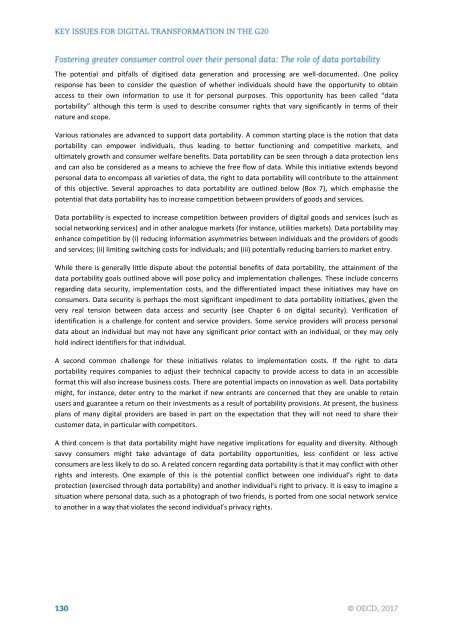KEY ISSUES FOR DIGITAL TRANSFORMATION IN THE G20
2jz0oUm
2jz0oUm
You also want an ePaper? Increase the reach of your titles
YUMPU automatically turns print PDFs into web optimized ePapers that Google loves.
The potential and pitfalls of digitised data generation and processing are well-documented. One policy<br />
response has been to consider the question of whether individuals should have the opportunity to obtain<br />
access to their own information to use it for personal purposes. This opportunity has been called “data<br />
portability” although this term is used to describe consumer rights that vary significantly in terms of their<br />
nature and scope.<br />
Various rationales are advanced to support data portability. A common starting place is the notion that data<br />
portability can empower individuals, thus leading to better functioning and competitive markets, and<br />
ultimately growth and consumer welfare benefits. Data portability can be seen through a data protection lens<br />
and can also be considered as a means to achieve the free flow of data. While this initiative extends beyond<br />
personal data to encompass all varieties of data, the right to data portability will contribute to the attainment<br />
of this objective. Several approaches to data portability are outlined below (Box 7), which emphasise the<br />
potential that data portability has to increase competition between providers of goods and services.<br />
Data portability is expected to increase competition between providers of digital goods and services (such as<br />
social networking services) and in other analogue markets (for instance, utilities markets). Data portability may<br />
enhance competition by (i) reducing information asymmetries between individuals and the providers of goods<br />
and services; (ii) limiting switching costs for individuals; and (iii) potentially reducing barriers to market entry.<br />
While there is generally little dispute about the potential benefits of data portability, the attainment of the<br />
data portability goals outlined above will pose policy and implementation challenges. These include concerns<br />
regarding data security, implementation costs, and the differentiated impact these initiatives may have on<br />
consumers. Data security is perhaps the most significant impediment to data portability initiatives, given the<br />
very real tension between data access and security (see Chapter 6 on digital security). Verification of<br />
identification is a challenge for content and service providers. Some service providers will process personal<br />
data about an individual but may not have any significant prior contact with an individual, or they may only<br />
hold indirect identifiers for that individual.<br />
A second common challenge for these initiatives relates to implementation costs. If the right to data<br />
portability requires companies to adjust their technical capacity to provide access to data in an accessible<br />
format this will also increase business costs. There are potential impacts on innovation as well. Data portability<br />
might, for instance, deter entry to the market if new entrants are concerned that they are unable to retain<br />
users and guarantee a return on their investments as a result of portability provisions. At present, the business<br />
plans of many digital providers are based in part on the expectation that they will not need to share their<br />
customer data, in particular with competitors.<br />
A third concern is that data portability might have negative implications for equality and diversity. Although<br />
savvy consumers might take advantage of data portability opportunities, less confident or less active<br />
consumers are less likely to do so. A related concern regarding data portability is that it may conflict with other<br />
rights and interests. One example of this is the potential conflict between one individual’s right to data<br />
protection (exercised through data portability) and another individual’s right to privacy. It is easy to imagine a<br />
situation where personal data, such as a photograph of two friends, is ported from one social network service<br />
to another in a way that violates the second individual’s privacy rights.


